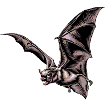Museum, University of Nebraska State

University of Nebraska State Museum: Mammalogy Papers
Document Type
Article
Date of this Version
February 1988
Abstract
The most derived fruit-eating bats have small canines, wide palates and molars with a distinctive labial rim. Paracone and metacone have moved from a dilambdodont position in the middle of the tooth to the labial side of the tooth where they form the labial cutting edge. Along with the well-developed and close fitting labial cutting edges of the premolars and canines, this cutting edge skirts nearly the entire perimeter of the palate. The labial rim of the lower teeth fit inside the labial rim of the upper teeth like two cookie cutters nesting one inside the other. Frugivores have a greater allocation of tooth area at the anterior end of the toothrow, while animalivorous species have more at the posterior end of the toothrow. The area occupied by canines of predators of struggling prey is greater than that for bats that eat non-struggling prey like fruit. In addition, frugivores have wider palates than long while many carnivores have longer palates than wide. Omnivores appear to have a more equal allocation of space to more kinds of teeth, particularly the incisors and non-molariform premolars, on the toothrow than do frugivores or animalivores. The mechanical nature of different food items is discussed and the suggestion made that describing foods in terms of their texture may be more important in tooth design than whether they are fruit or insect or vertebrate.


Comments
Published in Biological Journal of the Linnean Society 33 (1988), pp. 249-272. Copyright © 1988 The Linnean Society of London. Published by Blackwell Publishing. Used by permission. “The definitive version is available at “www.blackwell-synergy.com.”